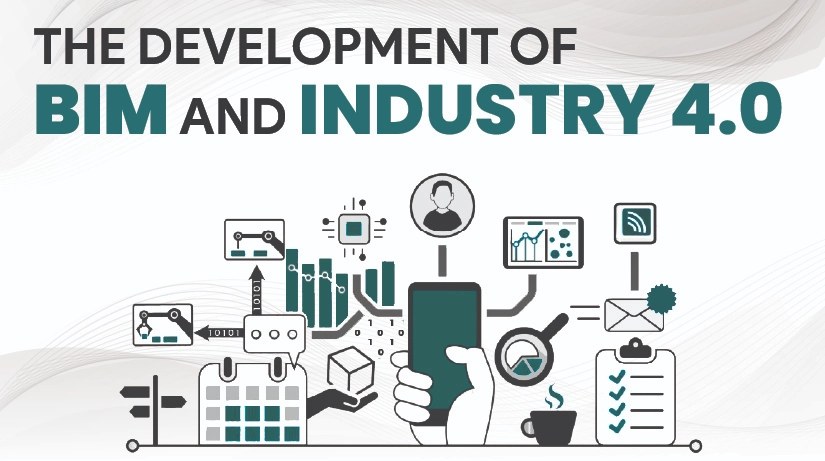The Development of BIM and Industry 4.0
Jan 31, 2024
Category: BIM / Digitization / Automation
Admin

Industry 4.0, built on pervasive connectivity, promises to transform different industries. The true meaning of it is subject to interpretation and the capacity to predict the future. Anticipated is the use of intelligent materials and technology to imbue our structures with intelligence. Experts predict that it will eventually refer to self-governing machines doing various tasks, with minimum human intervention.
However, there is a general consensus that signifies the use of technology to fundamentally enhance the process of designing and constructing our surroundings.
Digitalization means enhancing efficiency and resource utilization. And, it can be achieved via improved access to pertinent information, swift problem-solving and collaborative efforts in the design, building, and operation of projects. Engineering and construction organizations intend to allocate 5 percent of their yearly revenue towards digital operations solutions annually over the next 5 years.
Building Information Modeling (BIM) also called BIM management is a methodology that is shaping industry advancements by using digital technologies and processes at a global scale.
Moving forward from the past
It’s important to acknowledge that the construction industry is facing some hurdles. Throughout history, the industry has often faced challenges such as delays and unexpected costs. Unfortunately, these issues have become accepted as unavoidable. However, there is room for improvement and a brighter future ahead.
Industry 4.0 holds immense potential to bring about a transformative shift and establish a fresh standard for what can be achieved, rather than being limited by past accomplishments. BIM management represents the initial stage in this exciting evolution, aiming to establish a centralized repository for gathering digital information about a project or asset.
Even the most precise aspects of the industry have been dependent on analog techniques and processes that leave too much margin for expensive errors. The tape measure is a tool that continues to be used on construction projects worldwide.
It relies on the user’s ability to interpret and document the results, making it an essential and reliable tool. However, this type of analog data does not support the collaborative ecosystem required for modern construction projects. At this juncture, the professionals after a BIM management course can transform the entire scenario unfailingly.
The significance of digital data
Digital data is a crucial element of Industry 4.0. By having more access to precise and authentic data at every phase of an asset’s lifespan, including design, building, and maintenance, it is possible to achieve time and cost savings while minimizing mistakes.
The advantages of digital data are already evident to some extent with the early use of Building Information Modeling or BIM management. However, often, the development of digital assets to depict the constructed environment is not grounded on actual data, resulting in the underutilization of BIM.
Geospatial professionals are crucial in the field of BIM since they possess the ability to accurately map and locate intricate digital information in the physical environment. It is due to their unmatched skills achieved through a BIM course. Their expertise lets them specify project timelines, locations, and methods.
They may also help create a ‘digital twin’, a digital copy of a physical object that matches its appearance. By possessing an extensive geographic understanding of the desired location, along with the continuous flow of digital information collected on-site, it is possible to avoid mistakes and delays.
Connecting the traditional methods of the past with the digital future
The presence of digital data, however important, is just a minor advancement in connecting the traditional methods of the past with the digital future of the building sector. Industry 4.0 is supported by trust and cooperation across different industries.
In order to fully capitalize on the advantages of unrestricted information, geospatial engineers, surveyors, designers, and contractors must unite, openly share information and collectively address any challenges that arise.
Regular and continuous digital data gathering and validation methods of on-site circumstances enable project teams to detect inconsistencies between the intended design and the actual construction.
Any discrepancy may be detected and included in the project’s digital system to enable designers and contractors to evaluate and make well-informed, immediate choices about corrective measures, therefore avoiding expensive errors.
Surveys, such as the one conducted by the BIM Task Group in the UK, suggest that knowledge and understanding of Building Information Modeling through a BIM course is getting more prevalent. Nevertheless, there is still a lack of uniform understanding of the proper use of BIM; some individuals still see it just as a 3D modeling tool due to its origins in software.
As a result, the full promise of BIM, which is to provide guidance to all stakeholders across the whole process from planning to maintenance, is often not completely realized. Maximizing the potential of BIM and collectively implementing it would significantly advance Industry 4.0.
Practically, this implies that all stakeholders in a project, including those in design, planning, building, and maintenance need to collaborate inside a unified BIM data environment. This approach eliminates the usage of separate models or isolated data collection. This necessitates an unparalleled degree of cooperation and trust.
An outlook for the future
In order to accomplish Industry 4.0, firms must not only guarantee that their people have the necessary knowledge and cultural alignment, but also have a well-defined aim and vision of what constitutes success. An exemplary illustration of this is the United Kingdom’s Building Information Modeling (BIM) Alliance.
The British group comprised of industry leaders provides guidance on the use of BIM, as well as digital construction techniques, across several industries. Anne Kemp, chair of the BIM Alliance, describes BIM as ‘Better Information Management’, emphasizing the ultimate objective of BIM rather than its technical aspects.
The establishment of such advisory organizations in other sectors, which advocate for the benefits of digitization in the industry and provide practical guidance on effectively integrating new technology, may significantly propel the development of Industry 4.0. By advocating the principles of Industry 4.0, we can together propel our industry forward and enjoy the advantages it brings.
Conclusion
Construction is vital to the global economy. It is important yet less productive and inventive than other areas. However, this seems to be changing and numerous actors have realized the need to innovate to stay competitive. Thanks to Industry 4.0 technology, new forms of work are emerging fast.
Several significant enterprises in France and Quebec have implemented BIM, virtual and augmented reality, prefabrication, the Internet of Things (IoT), additive manufacturing, robotization, etc., but their adoption is still in its infancy, especially among small ventures. A truly digital revolution in the construction sector requires encouraging BIM and Industry 4.0 integration.
About TechnoStruct Academy:
TechnoStruct Academy is the educational arm of TechnoStruct, LLC, a registered design engineering firm based in California. It offers specialized BIM training programs for architecture, MEP, and BIM Management.
Our BIM Certification Courses:
BIM-Ready+: Become a BIM Management professional specialized in managing all ASMEPF projects working with open BIM and interoperability with a credible BIM Manager Certification.
BIM-Ready Complete: Become a BIM Engineer specialized in all ASMEPF (Architectural, Structural, Mechanical, Electrical, Plumbing, and Fire Protection) disciplines working with open BIM and interoperability.
BIM-Ready (Arch+Structure): Specialize in BIM Fundamentals, Conceptual Design, Sustainable Design, Design Development, and Construction Documentation in the BIM Environment with this BIM Architect Course.
BIM-Ready (MEP): Become an MEP BIM Engineer specializing in BIM Fundamentals, HVAC, Electrical, Plumbing and Fire Fighting, Design, and Modeling in a BIM Environment.
Bexel Manager Certification Program: This program teaches you about BEXEL Manager, a software that brings together key 3D, 4D, 5D, and BIM features, making it quick and easy to embrace BIM processes and technology for speedy project implementation.








